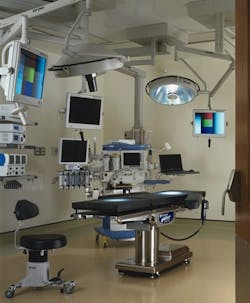Prentice Hospital Shares Lessons Learned During New Construction
By Michael T. Stark and Larry Wilson
Soon after Northwestern Memorial HealthCare (NMH) completed its flagship replacement hospital in 1999, the project team, building occupants, and staff members documented the lessons they learned from the project. So, when a team - composed of many of the same people - began planning a women's hospital on the NMH campus 3 years later, the design foundation was already established.
From Day One, and lasting through occupancy in Fall 2007, the project team weighed in on all design decisions, with each stakeholder assuming ownership of his/her piece of the project. Coupled with this collaboration came flexibility, sustainability, and commissioning: three things NMH was looking for. Today, after 1 year in operation, the project team for the 940,000-square-foot Prentice Women's Hospital in downtown Chicago shares the lessons they learned, and how those lessons went from paper to practice.
Lesson #1: Achieve Flexibility
Modern-day healthcare facilities must accommodate the perpetual growth and transformation of specialized departments and their specific MEP infrastructure needs.
Since opening its doors last year, Prentice has already initiated three major renovation projects: a clinic remodel (taking place while the clinic remains open); the creation of a mammography imaging work area, and turning shelled space into bed storage; and creating lab and clinic rooms on two partial floors, which will be used by the Northwestern Medical Faculty Foundation (NMFF).
To reconfigure the fourth-floor Breast Center Clinic, smoke walls had to be relocated, forcing the mechanical and electrical life-safety systems to accommodate the new barriers. Because of NMFF's requirement for a separate identity, new electric metering was also provided.
Flexibility was a key design principle. The team made sure that MEP, fire protection, medical, and information systems could deliver the additional requirements for any medical program put into the building; countless sessions addressed future expansion needs.
Two mechanical rooms for air-handling units (AHUs) were designed - one with eight units for the first 11 stories, and another with six units for floors 12 through 17 of the high-rise portion of the building. Each AHU is cross-connected and looped together at every floor, providing a reliable system with an easy way to accommodate department renovations or modifications.
The chilled water loop - also linked - provides additional opportunity for growth, with its slightly oversized, 2.5-inch chilled water piping sub-outs, which are clad with cap and valve connections to meet current and future needs.
High-pressure 125-psi steam boilers were specified. Again, by using slightly oversized piping, the hospital can reduce output boiler pressure depending on current and future medical equipment needs, which results in the reduction of energy consumed by the boiler plant.
The flexibility of the HVAC system also benefits the smoke-management system. Divided into seven vertical fire/smoke zones, the hospital utilizes its regular supply and return air terminal units for smoke management during a fire. When smoke is detected within a zone, its terminal units - and those in surrounding zones - automatically modulate to create negatively pressurized air balance in the affected area. Then, the units open to increase the air change rate and remove smoke faster, while automatically switching to "smoke mode," which brings in 100-percent outdoor and relief air.
Lesson #2: Realize Sustainability
Seeking a truly sustainable design, Prentice used energy-efficient equipment and controls, and employed operational strategies that reduce consumption and maximize patient care. LEED Silver certification is pending.
The hospital's energy-performance model revealed an estimated annual energy consumption of 205,034 BTU/ft²/yr, including process loads, vs. 185,791 BTU/ft²/yr with energy-efficient strategies. This represents an annual energy-consumption reduction of almost 10 percent; without process loads, it's a 12-percent reduction.
Mechanical systems are the building's largest energy user, and they provide the greatest opportunity for efficiency gains. The AHUs, as well as the lobbies, were designed to provide 100-percent outside air for the operation of the airside economizer and the smoke-management system. Looped together and cross-connected, each group of AHUs allows the highest level of diversity to be taken, resulting in the need for smaller airflow capacity equipment and, therefore, less fan horsepower and fan heat demand.
These units provide variable air volume (VAV) through the use of variable speed drives on the centrifugal fans and variable pitch in-flight vane-axial fans; an enthalpy-controlled airside economizer provides free cooling during mild and cold weather.
Prentice is equipped with four electric centrifugal chillers and variable-speed-drive pumps that are piped in a primary-only variable flow arrangement with flow maintained at the minimum design rate by each chiller using a bypass. One of the four chillers is equipped with its own variable frequency drive and is specifically sized to handle the building's wintertime process loads. Each AHU chilled water coil and supplement chilled water fan coil unit is equipped with a pressure-independent control valve to minimize the required chilled water flow and maximize its differential temperature at each coil.
Operating strategies to reduce cooling energy include turning the chilled water supply temperature up during off-peak periods, and using all of the cooling tower cells with reduced airflow by the condenser water system for as many hours during the year as possible, maximizing available surface area for heat transfer.
The hospital's three high-pressure, gas-fired tube steam boilers run at a full-load efficiency of 83 percent, meeting the demands of sterilizer equipment and sterile rooms, the hospital's domestic hot water and clean steam humidification, and supplemental kitchen functions. Flue gas economizers, which recycle waste heat from boiler stacks to preheat the boiler feed water, elevate boiler efficiencies to 86 percent, exceeding standards by as much as 6 percent. High-pressure steam piping is also sized to allow the hospital to gain added efficiency by dropping the output steam pressure.
All three boilers are modulating with a low fire ignition position and a high turndown ratio of 8:1. Coupled with automatic surface-blowdown controls that reduce the chemicals used for boiler water treatment and the water used for boiler make-up, heating expenditure is also reduced.
Complementing the sustainable efforts of the HVAC system are 40,000 square feet of highly reflective roofing, and another 14,000 square feet of rooftop vegetation. As much as 98 percent of the total roof area displays energy-efficient properties, resulting in a combined R-value of 17.5.
Championing infection control and indoor air quality, Prentice outfitted the building with MERV 17 HEPA filters vs. code-required MERV 14 filters. This not only provides a cleaner environment, but also allows the hospital to repurpose space. These final filters capture up to 99.97 percent of tiny airborne particles.
To ensure thermal comfort, VAV boxes were specified and grouped according to similarly occupied spaces to maintain desired room temperatures, regardless of orientation to the sun or internal heat gains. The return VAV medium pressure system was employed to permit precise pressurization control in the hospital's sensitive pressure rooms, with the ability to raise and lower the return box accordingly. The VAV system purposely exceeds code by supporting 25 air changes per hour in the operating rooms while preventing recirculation through the central air system.
HVAC controls provide 78 percent of spaces with individual temperature management; ceiling-mounted radiant heating panels provide a comfortable environment for sedentary patients.
Energy-efficient plumbing systems include low-flow fixtures and faucets, and laminar flow devices, which conserve water without aerating it into breathable droplets that might negate infection control. High-efficiency, steam-fired, semi-instantaneous water heaters and a booster pump system with a variable speed drive reduce heating and pumping energy. Domestic water heaters re-circulate hot water, improving delivery times and minimizing water waste while increasing contamination control and bacteria spread.
Employing lighting controls helped the hospital achieve energy efficiency and patient comfort with illumination as well. A typical Prentice hospital room has multiple switches, including caregiver lighting and patient task lighting, and a variety of lighting levels, including dimming capabilities and occupancy sensors. T8HO fluorescent lamps and high-efficiency ballasts are also used.
Lesson #3: Conduct Commissioning
As the process by which a facility's procedures, maintenance, and equipment are tested for operational compliance and functionality, commissioning at Prentice began with the selection of a commissioning agent (CA) during the schematic design phase. The CA verified that the design intent was carried out and that systems were fully maintainable, continuing a full year after occupancy to confirm maximum efficiency.
Total building commissioning was performed, going beyond MEP systems; clinical and IT systems were tested, and "people commissioning" was performed (making sure maintenance personnel and clinical staff understand the systems and how they work).
Overall building performance during the hospital's first year was very good, thanks to changes made as a direct result of the commissioning process, according to David Cha, manager and principal engineer at NMH. A key component was the hospital's blackout test: With the utility company, city and state inspectors, 40-plus contractors, and 50 staff members on hand, Prentice shut down its MEP systems over a period of 3 days. Checking the critical power systems, emergency lighting, elevators, back-up generators, fire-protection systems, fire-alarm and computer systems, medical gas systems, and electrical systems in blackout mode, Prentice found out how its systems would perform during a power outage. Cha indicates that many issues were identified during the planning stages of the test, and during the test itself.
Commissioning benefited the building-automation system (BAS) as well. A fully automated control system within the BAS continually takes air-temperature readings; graphics displayed in red indicate areas that feel too warm, and graphics in blue indicate spaces that are too cool. Extensive testing prior to occupancy allowed BAS operators to maintain patient comfort from Day One; hot/cold calls at Prentice were reduced by as much as 70 percent from what was experienced after the opening of NMH's flagship hospital 8 years earlier.
Extensive commissioning was also done on the smoke-management system because the ADA limits the amount of negative pressure allowed in a fire zone in order to ensure proper operation of egress doors. Over a period of 2 months, commissioning tests were performed on the 67 fire zones, simulating the highest degree of negative pressure possible to guarantee that all egress doors would be operational during a smoke event.
This successful project was just the beginning for NMH. In the last year, they've formed a task force - the Blue Skies Group - that's aimed at evaluating the energy efficiency and sustainability of all NMH buildings and projects. With the lessons learned during the Prentice project about flexibility, sustainability, and commissioning, Cha says the organization might use Prentice Women's Hospital as a basis for future projects.
Michael T. Stark is vice president, and Larry Wilson is senior vice president, at Chicago-based Environmental Systems Design.


